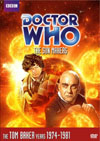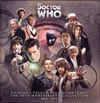DVD Extras include:
His subject matter strikes a chord far louder than anything that "Image of the Fendahl" (the previous story) brought up earlier, encouraging the entire production team to aid and embellish the details that make the story so worthwhile. He also delivers a solid on-screen plot that keeps the Doctor, Leela, and even the hastily added K9 busy confronting the characters and issues at hand. But best of all, he continues his tradition of creating wonderful new characters to populate the screen. Gatherer Hade is typical Holmes, the not-so-competent official high up in an organization, with too high an opinion of himself and just begging for someone to come in and make fun of him. The Collector is a much more unique creation, the symbolic realization of taxation, usury, and corporate exploitation gone wild. Actor Henry Woolf, given superb make-up, costume, and mobothrone wheelchair prop, does supreme justice to this key role. He and Richard Leech playing Gatherer Hade lead a wonderful cast who all put in good performances that make the story work well. Also of note in the cast as Goudry is Michael Keating, who would go on to play Vila, my favourite character in Terry Nation's sci-fi series Blake's 7, and be the only actor to feature in every single episode of that show. It is a great joy to see him playing not too dissimilar a character in a poignant Doctor Who story as well.
The story is also a bit skimpy with grand-scale establishing shots, lacking the kind of opening space panoramas that many other stories this season were blessed with. A shot of Pluto from space, with six suns around it would have been a great touch, as would have some good model work for the Megropolis One city. The composite shot appearing on the TARDIS scanner and again later as a cutaway view lacks a certain believability, as though it would be an impossibility in three dimensions, and therefore must only have two. The opening sequence of the story is not too impressive either, beginning with Cordo in an empty and completely white corridor set, followed by an introduction to Gatherer Hade's office that makes it look like a pile of oversized children's building blocks assembled by someone trying to make an indoor play fort or a sand-castle. This type of minimalist set design works as shot throughout most of the story, when one can assume there are proper walls in the darkness behind the highlighted bits in obvious sight, but the entrance to Hade's office destroys the needed illusion from the beginning, where it is all too obvious that there is no wall between one side of the door and the other, and where the view from his desk can see into the rib cage entrance hall from its outside, rendering it redundant. This prompts the viewer to scrutinize the sets more closely than normal during the rest of the story, which is not a good thing. Blank white corridors are also not too riveting, but at least these match up with the long corridor filmed on location. Perhaps it wasn't such a great location after all, despite its impressive size. In large part, the location material works really well for the story, giving it a sense of scale and enough diversity to make the industrial city society believable and selling many of the set-pieces that get mixed in afterwards.
Comments on this article are welcome. You may contact the author from this page:
|










